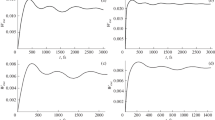Abstract
The Lorentz–Maxwell model of dispersion of light has been analysed in this paper to determine the damping coefficient of the electrons in optically transparent glasses at the true resonance frequency in the ultraviolet region where glass is opaque. For this, we needed the refractive indices of glass in the optical frequency range. We argue that the true resonance condition in the absorption region prevails when the frequency at which the absorption coefficient is maximum is the same as the frequency at which the average energy per cycle of the electrons is also a maximum. We have simultaneously solved the two equations obtained from the two maxima conditions numerically to arrive at a unique solution for the true resonance frequency and the damping coefficient at this frequency. Assuming the damping coefficient to be constant over a small frequency range in the absorption region, we have determined the frequency at which the extinction coefficient is maximum using our theory. This frequency matches well with the published experimental data for silica glasses.
Similar content being viewed by others
References
S Chakrabarti, Phys. Educ. 23, 167 (2006) (South Asian Publishers, New Delhi, India)
R W Christy, Am. J. Phys. 40, 1403 (1972)
R Kitamura, L Pilon and M Jonasz, Appl. Opt. 46(33), 8118 (2007)
I F Almog, M S Bradley and V Bulovic, The Lorentz oscillator and its applications (MIT OpenCourseWare, MIT6-007S11/lorentz, 2011)
M Born and E Wolf, Principles of optics, 6th edn (Pergamon, New York, 1980) p. 85
C Kittel, Introduction to solid state physics, 5th edn (Wiley Eastern Limited, New Delhi, 1976) p. 405.
E Hecht, Optics, 4th edn (Pearson Education, Delhi, India, 2002) pp. 71, 85, 70, 128
R P Feynman, R B Leighton and M Sands, The Feynman lectures on physics (Narosa Publishing House, New Delhi, India, 2003) Vol. 2, pp. 1211, 1210
K E Oughstun and N A Cartwright, Opt. Express11(13), 1541 (2003)
D B Tanner, Optical effects in solids, www.phys.ufl.edu/tanner/notes.pdf (2013)
D Kleppner and R J Kolenkow, An introduction to mechanics (Tata McGraw Hill, New Delhi, India, 1973) p. 426
W Heitler, The quantum theory of radiation, 3rd edn (Oxford University Press, 1954) p. 163
F Seitz, The modern theory of solids (McGraw-Hill International Series In Pure And Applied Physics, 1940) p. 629
J D Jackson, Classical electrodynamics, 3rd edn (John Wiley & Sons, Inc., 1999) p. 314
F A Jenkins and H E White, Fundamentals of optics, 3rd edn (McGraw-Hill Book Company, 1957) p. 486
Acknowledgements
The author would like to thank Prof. Debashis Mukherjee for some helpful comments on the paper.
Author information
Authors and Affiliations
Appendix A
Appendix A
Equations (11) and (12) can be easily inverted and we get [2]
and
In eqs (A.1) and (A.2) we express \(\epsilon _1\) and \(\epsilon _2\) as functions of frequency using eqs (11) and (12), respectively. After a fairly straightforward algebra, we arrive at the final expressions for \(n^2\) and \(\kappa ^2\) as functions of frequency \(\omega \) as,
where
These equations are exact and will be used for determining n and \(\kappa \) in the resonance region in the ultraviolet region. It can be easily checked that in the limit \(\gamma \) tending to zero, \(\kappa \) becomes zero at all frequencies and vice versa. Thus, the medium is transparent in the optical frequencies as it should. In this limit, the refractive index n satisfies a relation which has been used in the first place to get the parameters \(\omega _n\) and \(\omega _p\) [1].
Rights and permissions
About this article
Cite this article
Chakrabarti, S. Determination of the damping coefficient of electrons in optically transparent glasses at the ultraviolet absorption region. Pramana - J Phys 96, 44 (2022). https://doi.org/10.1007/s12043-021-02290-y
Received:
Revised:
Accepted:
Published:
DOI: https://doi.org/10.1007/s12043-021-02290-y




